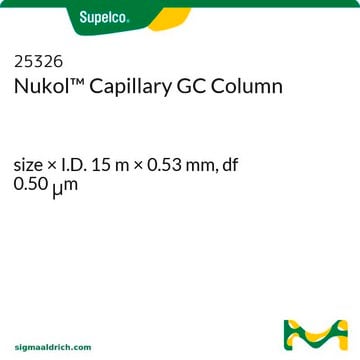13023AST
Astec® CHIROBIOTIC® R Chiral (5 μm) HPLC Columns
L × I.D. 15 cm × 4.6 mm, HPLC Column
Sign Into View Organizational & Contract Pricing
All Photos(1)
About This Item
UNSPSC Code:
41115700
eCl@ss:
32110501
NACRES:
SB.52
Recommended Products
product name
Astec® CHIROBIOTIC® R Chiral HPLC Column, 5 μm particle size, L × I.D. 15 cm × 4.6 mm
material
stainless steel column
description
HPLC column
product line
Astec®
packaging
pkg of 1 ea
manufacturer/tradename
Astec®
parameter
0-45 °C temperature
241 bar pressure (3500 psi)
technique(s)
HPLC: suitable
LC/MS: suitable
L × I.D.
15 cm × 4.6 mm
matrix
high-purity silica gel particle platform
fully porous particle
matrix active group
ristocetin A glycopeptide phase
particle size
5 μm
pore size
100 Å
operating pH range
3.5-6.8
separation technique
chiral
Looking for similar products? Visit Product Comparison Guide
General description
CHIROBIOTIC® R, based on the ristocetin A glycopeptide covalently bonded to high purity silica particles, has shown particular applicability to enantiomers of anionic compounds. Selectivity on CHIROBIOTIC® R strongly correlates to the organic modifier, favoring the alcohol-type mobile phases by a large margin.
CHIROBIOTIC FAQs
CHIROBIOTIC Reference Bibliography
Chiral Product Literature
- Bonded phase: Ristocetin A
- Operating pH range: 3.5 - 6.8
- Particle diameter: 5, 10 or 16 μm
- Pore size: 100 Å
CHIROBIOTIC FAQs
CHIROBIOTIC Reference Bibliography
Chiral Product Literature
Legal Information
Astec is a registered trademark of Merck KGaA, Darmstadt, Germany
CHIROBIOTIC is a registered trademark of Sigma-Aldrich Co. LLC
Choose from one of the most recent versions:
Already Own This Product?
Find documentation for the products that you have recently purchased in the Document Library.
Enzyme-catalyzed synthesis of (R)- and (S)-3-hydroxy-3-(10-alkyl-10H-phenothiazin-3-yl)propanoic acids
Brem, Jurgen, et al.
Tetrahedron Asymmetry, 21 (3), 365-373 (2010)
H Henry et al.
Biomedical chromatography : BMC, 26(4), 425-428 (2011-08-16)
D-lactic acid in urine originates mainly from bacterial production in the intestinal tract. Increased D-lactate excretion as observed in patients affected by short bowel syndrome or necrotizing enterocolitis reflects D-lactic overproduction. Therefore, there is a need for a reliable and
P Dehouck et al.
Journal of chromatography. A, 1010(1), 63-74 (2003-09-25)
Erythromycin is a mixture of macrolide antibiotics produced by Saccharopolyspora erythreas during fermentation. A new method for the analysis of erythromycin by liquid chromatography has previously been developed. It makes use of an Astec C18 polymeric column. After validation in
Enzyme-catalyzed synthesis of (R)- and (S)-3-heteroaryl-3-hydroxy-propanoic acids and their derivatives
Brem, Jurgen, et al.
Tetrahedron Asymmetry, 20 (4), 489-496 (2009)
G Bellucci et al.
Chirality, 6(3), 207-212 (1994-01-01)
The rabbit liver microsomal biotransformation of alpha-methylstyrene (1a), 2-methyl-1-hexene (1b), 2,4,4-trimethyl-1-pentene (1c), and 1,3,3-trimethyl-1-butene (1d) has been investigated with the aim at establishing the enantioface selection of the cytochrome P-450-promoted epoxidation of the double bond and the enantioselectivity of microsomal
Our team of scientists has experience in all areas of research including Life Science, Material Science, Chemical Synthesis, Chromatography, Analytical and many others.
Contact Technical Service






